Wenlong Cai
Two Enhanced-rate Power Allocation Strategies for Active IRS-assisted Wireless Network
Oct 18, 2023Abstract:Due to its ability of overcoming the impact of double-fading effect, active intelligent reflecting surface (IRS) has attracted a lot of attention. Unlike passive IRS, active IRS should be supplied by power, thus adjusting power between base station (BS) and IRS having a direct impact on the system rate performance. In this paper, the active IRS-aided network under a total power constraint is modeled with an ability of adjusting power between BS and IRS. Given the transmit beamforming at BS and reflecting beamforming at IRS, the SNR expression is derived to be a function of power allocation (PA) factor, and the optimization of maximizing the SNR is given. Subsequently, two high-performance PA strategies, enhanced multiple random initialization Newton's (EMRIN) and Taylor polynomial approximation (TPA), are proposed. The former is to improve the rate performance of classic Netwon's method to avoid involving a local optimal point by using multiple random initializations. To reduce its high computational complexity, the latter provides a closed-form solution by making use of the first-order Taylor polynomial approximation to the original SNR function. Actually, using TPA, the original optimization problem is transformed into a problem of finding a root for a third-order polynomial.Simulation results are as follows: the first-order TPA of SNR fit its exact expression well, the proposed two PA methods performs much better than fixed PA in accordance with rate, and appoaches exhaustive search as the number of IRS reflecting elements goes to large-scale.
STAR-RIS-UAV Aided Coordinated Multipoint Cellular System for Multi-user Networks
May 22, 2023Abstract:Different with conventional reconfigurable intelligent surface (RIS), simultaneous transmitting and reflecting RIS (STAR-RIS) can reflect and transmit the signals to the receiver. In this paper, to serve more ground users and increase the deployment flexibility, we investigate an unmanned aerial vehicle equipped with a STAR-RIS (STAR-RIS-UAV) aided wireless communications for multi-user networks. Energy splitting (ES) and mode switching (MS) protocols are considered to control the reflection and transmission coefficients of STAR-RIS elements. To maximize the sum rate of the STAR-RIS-UAV aided coordinated multipoint cellular system for multi-user networks, the corresponding beamforming vectors as well as transmitted and reflected coefficients matrices are optimized. Specifically, instead of adopting the alternating optimization, we design an iteration method to optimize all variables for both ES and MS protocols at the same time. Simulation results reveal that STAR-RIS-UAV aided wireless communication system has a much higher sum rate than the system with conventional RIS or without RIS. Furthermore, the proposed structure is more flexible than a fixed STAR-RIS and could greatly promote the sum rate.
Machine-learning-aided Massive Hybrid Analog and Digital MIMO DOA Estimation for Future Wireless Networks
Jan 12, 2022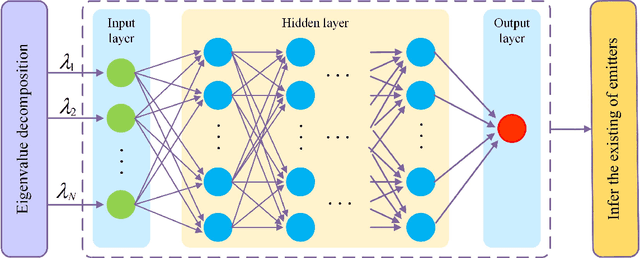
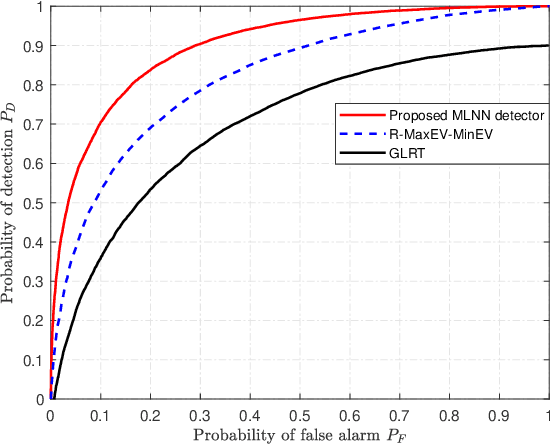
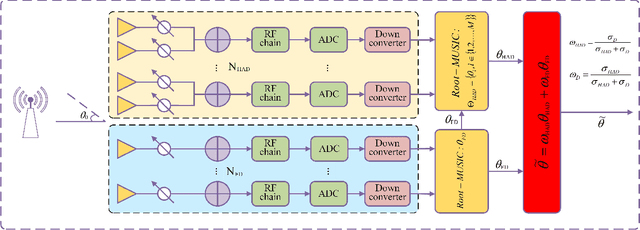
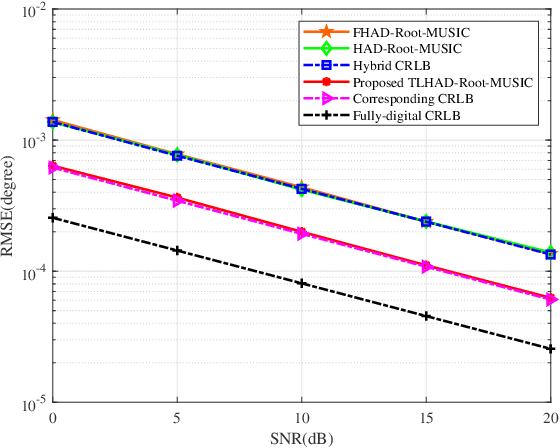
Abstract:Due to a high spatial angle resolution and low circuit cost of massive hybrid analog and digital (HAD) multiple-input multiple-output (MIMO), it is viewed as a key technology for future wireless networks. Combining a massive HAD-MIMO with direction of arrinal (DOA) will provide a high-precision even ultra-high-precision DOA measurement performance approaching the fully-digital (FD) MIMO. However, phase ambiguity is a challenge issue for a massive HAD-MIMO DOA estimation. In this paper, we review three aspects: detection, estimation, and Cramer-Rao lower bound (CRLB) with low-resolution ADCs at receiver. First, a multi-layer-neural-network (MLNN) detector is proposed to infer the existence of passive emitters. Then, a two-layer HAD (TLHAD) MIMO structure is proposed to eliminate phase ambiguity using only one-snapshot. Simulation results show that the proposed MLNN detector is much better than both the existing generalized likelihood ratio test (GRLT) and the ratio of maximum eigen-value (Max-EV) to minimum eigen-value (R-MaxEV-MinEV) in terms of detection probability. Additionally, the proposed TLHAD structure can achieve the corresponding CRLB using single snapshot.
Beamforming and Transmit Power Design for Intelligent Reconfigurable Surface-aided Secure Spatial Modulation
Jun 07, 2021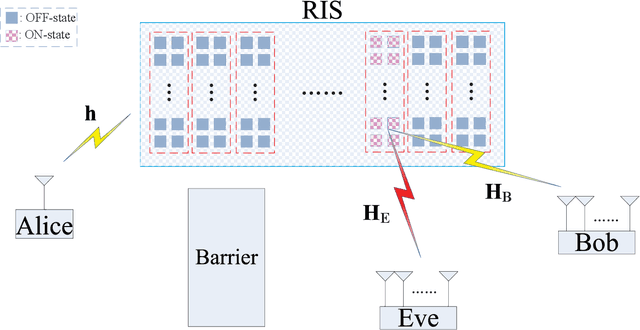
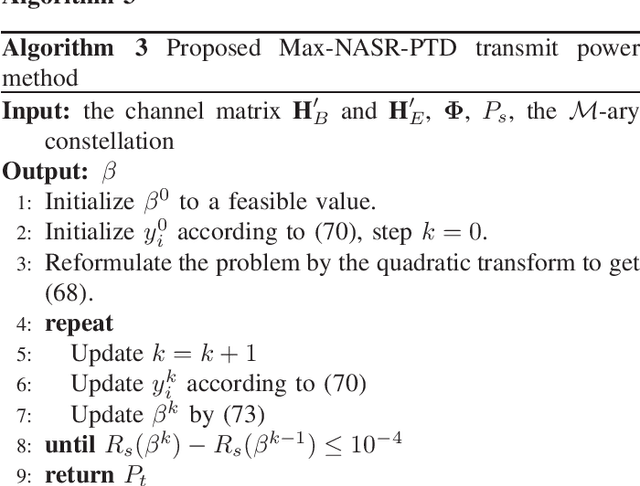
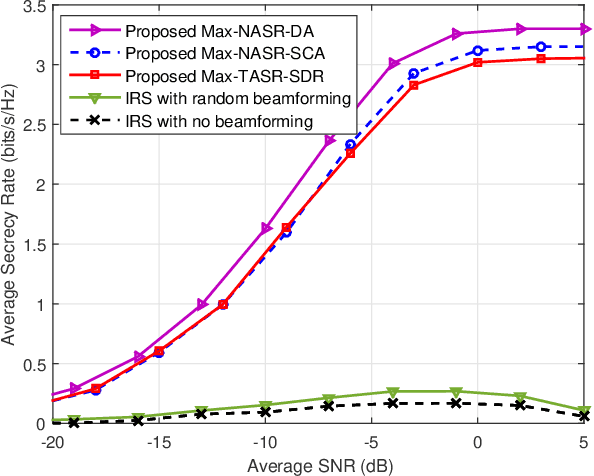
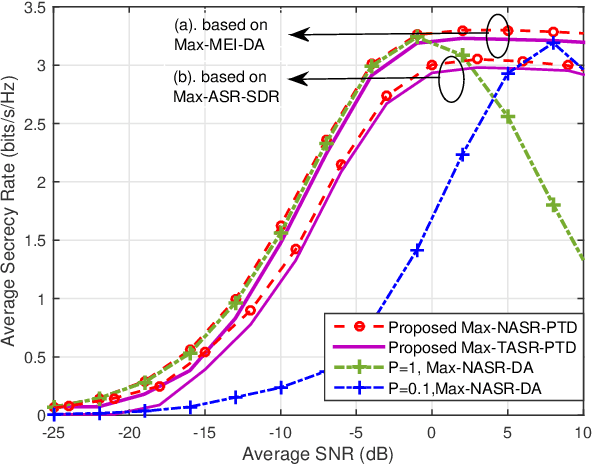
Abstract:Intelligent reflecting surface (IRS) is a promising solution to build a programmable wireless environment for future communication systems, in which the reflector elements steer the incident signal in fully customizable ways by passive beamforming. In this paper, an IRS-aided secure spatial modulation (SM) is proposed, where the IRS perform passive beamforming and information transfer simultaneously by adjusting the on-off states of the reflecting elements. We formulate an optimization problem to maximize the average secrecy rate (SR) by jointly optimizing the passive beamforming at IRS and the transmit power at transmitter under the consideration that the direct pathes channels from transmitter to receivers are obstructed by obstacles. As the expression of SR is complex, we derive a newly fitting expression (NASR) for the expression of traditional approximate SR (TASR), which has simpler closed-form and more convenient for subsequent optimization. Based on the above two fitting expressions, three beamforming methods, called maximizing NASR via successive convex approximation (Max-NASR-SCA), maximizing NASR via dual ascent (Max-NASR-DA) and maximizing TASR via semi-definite relaxation (Max-TASR-SDR) are proposed to improve the SR performance. Additionally, two transmit power design (TPD) methods are proposed based on the above two approximate SR expressions, called Max-NASR-TPD and Max-TASR-TPD. Simulation results show that the proposed Max-NASR-DA and Max-NASR-SCA IRS beamformers harvest substantial SR performance gains over Max-TASR-SDR. For TPD, the proposed Max-NASR-TPD performs better than Max-TASR-TPD. Particularly, the Max-NASR-TPD has a closed-form solution.
On Performance Loss of DOA Measurement Using Massive MIMO Receiver with Mixed-ADCs
Apr 06, 2021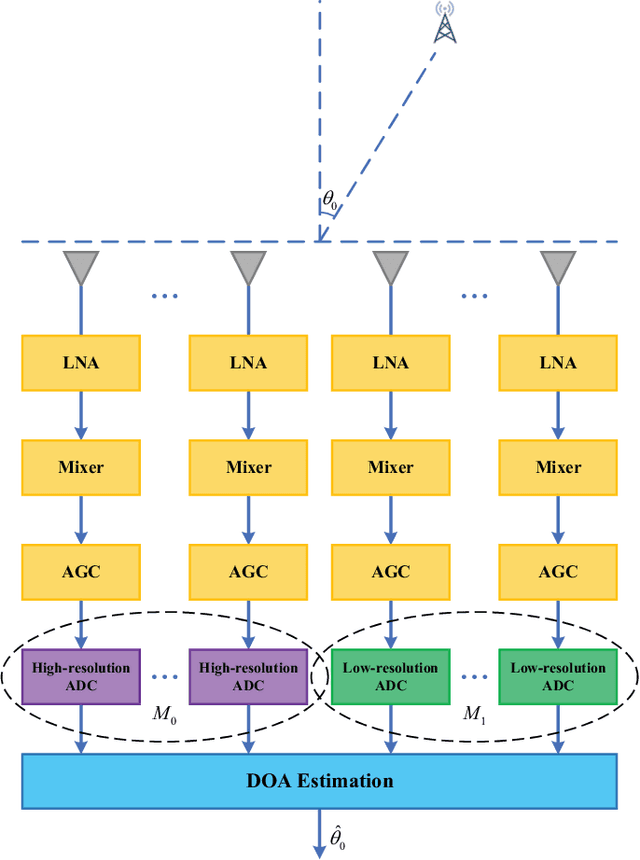
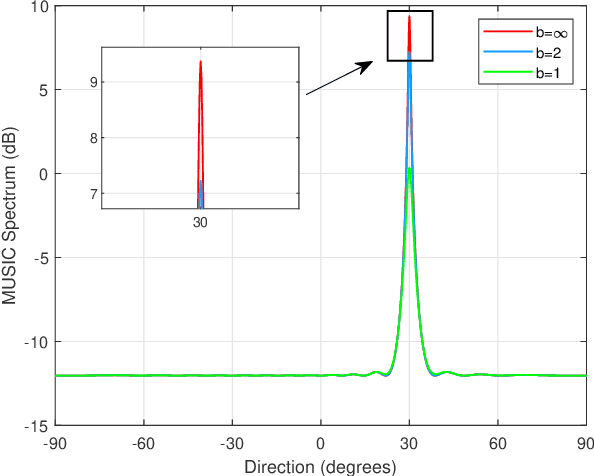
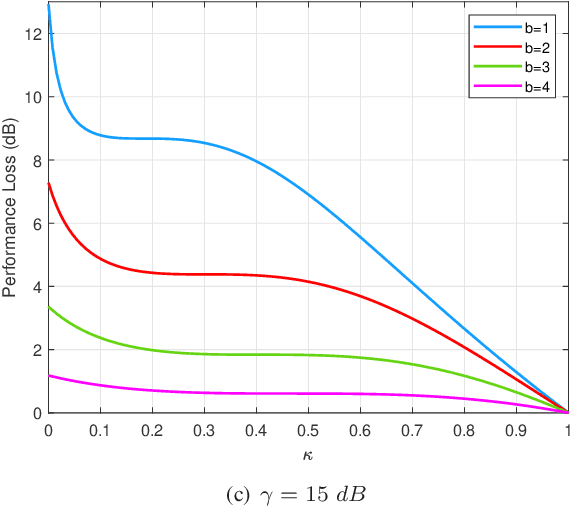
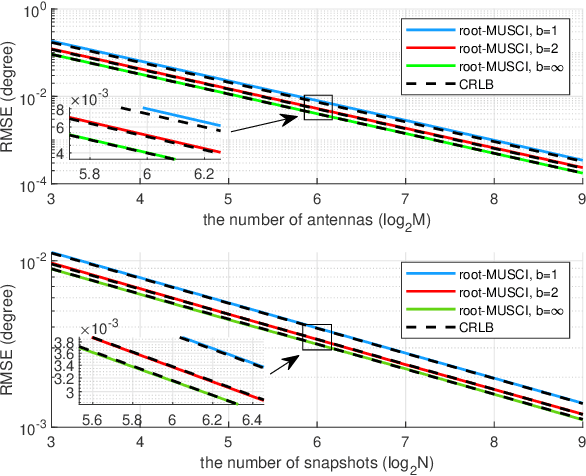
Abstract:High hardware cost and high power consumption of massive multiple-input and multiple output (MIMO) are still two challenges for the future wireless communications including beyond 5G. Adopting the low-resolution analog-to-digital converter (ADC) is viewed as a promising solution. Additionally, the direction of arrival (DOA) estimation is an indispensable technology for beam alignment and tracking in massive MIMO systems. Thus, in this paper, the performance of DOA estimation for massive MIMO receive array with mixed-ADC structure is first investigated, where one part of radio frequency (RF) chains are connected with high-resolution ADCs and the remaining ones are connected with low-resolution ADCs. Moreover, the Cramer-Rao lower bound (CRLB) for this architecture is derived based on the additive quantization noise model approximation for the effect of low-resolution ADCs. Then, the root-MUSIC method is designed for such a receive structure. Eventually, a performance loss factor and the associated energy efficiency factor is defined for analysis in detail. Simulation results find that a mixed-ADC architecture can strike a good balance among RMSE performance, circuit cost and energy efficiency. More importantly, just 1-4 bits of low-resolution ADCs can achieve a satisfactory performance for DOA measurement.
Communication-efficient Coordinated RSS-based Distributed Passive Localization via Drone Cluster
Apr 01, 2021


Abstract:Recently, passive unmanned aerial vehicle (UAV) localization has become popular due to mobility and convenience. In this paper, we consider a scenario of using distributed drone cluster to estimate the position of a passive emitter via received signal strength (RSS). First, a distributed majorizeminimization (DMM) RSS-based localization method is proposed. To accelerate its convergence, a tight upper bound of the objective function from the primary one is derived. Furthermore, to reduce communication overhead, a distributed estimation scheme using the Fisher information matrix (DEF) is presented, with only requiring one-round communication between edge UAVs and center UAV. Additionally, a local search solution is used as the initial value of DEF. Simulation results show that the proposed DMM performs better than the existing distributed Gauss-Newton method (DGN) in terms of root of mean square error (RMSE) under a limited low communication overhead constraint. Moreover, the proposed DEF performs much better than MM in terms of RMSE, but has a higher computational complexity than the latter.
UAV-enabled optimal position selection for secure and precise wireless transmission
Mar 31, 2021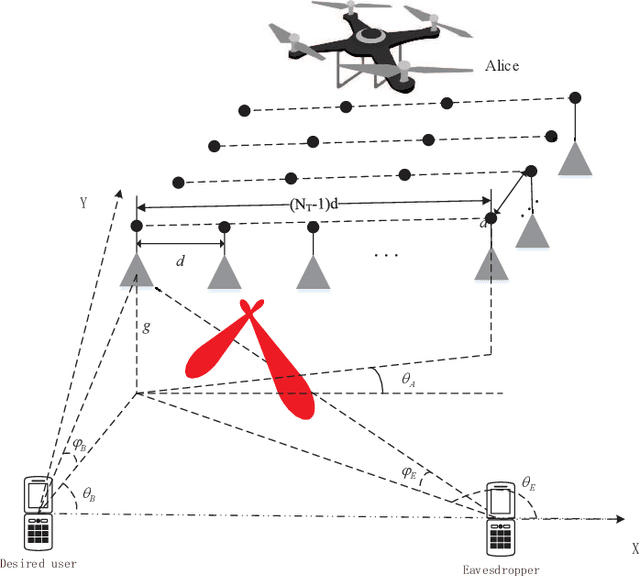
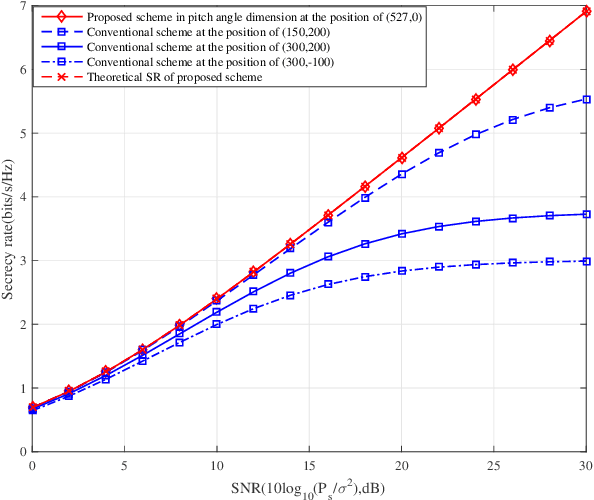


Abstract:In this letter, two unmanned-aerial-vehicle (UAV) optimal position selection schemes are proposed. Based on the proposed schemes, the optimal UAV transmission positions for secure precise wireless transmission (SPWT) are given, where the maximum secrecy rate (SR) can be achieved without artificial noise (AN). In conventional SPWT schemes, the transmission location is not considered which impacts the SR a lot. The proposed schemes find the optimal transmission positions based on putting the eavesdropper at the null point. Thus, the received confidential message energy at the eavesdropper is zero, and the maximum SR achieves. Simulation results show that proposed schemes have improved the SR performance significantly.
 Add to Chrome
Add to Chrome Add to Firefox
Add to Firefox Add to Edge
Add to Edge